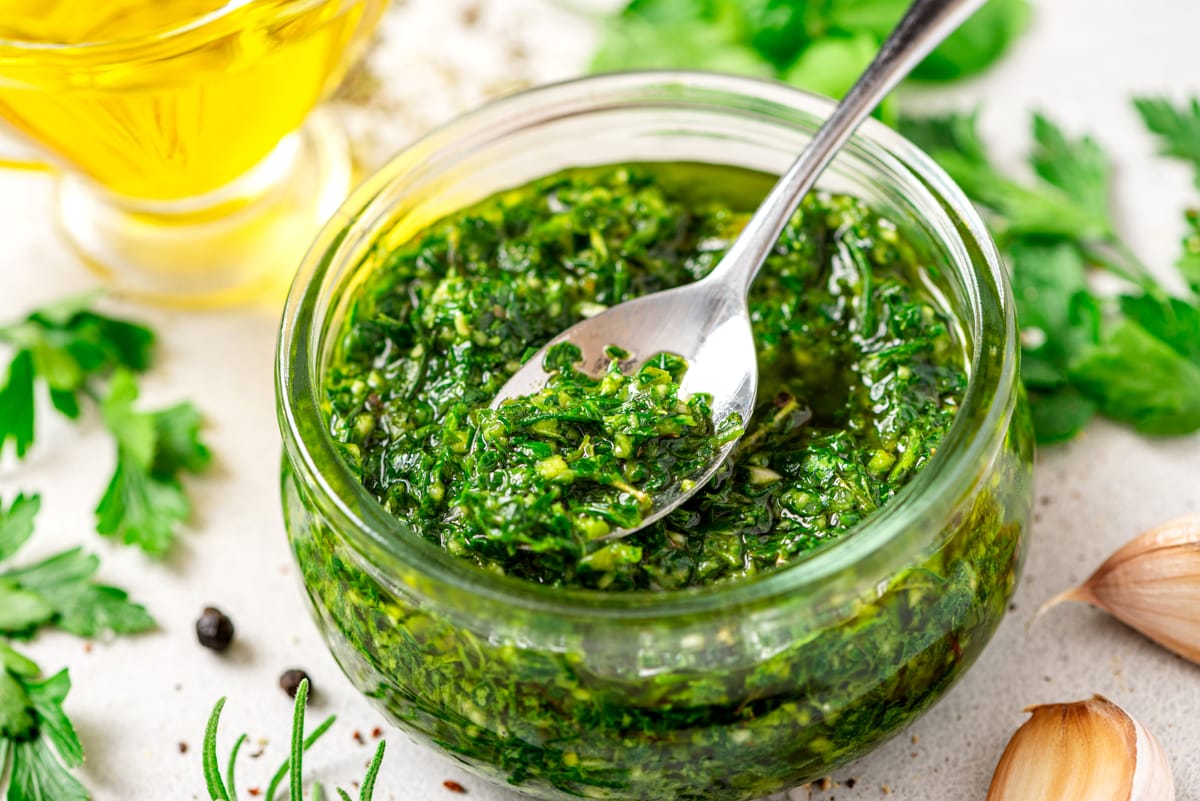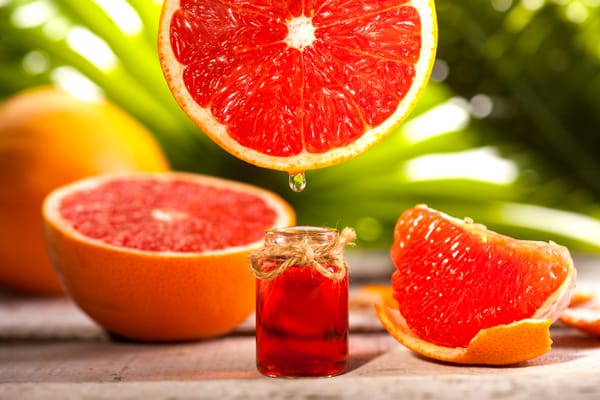Chimichurri Recipe: A Zesty, Authentic Taste of Argentina

I want to tell you about a sauce that's so good, it'll make your taste buds dance the tango. It's called chimichurri, and it's the secret weapon of every grill master in Argentina. This zesty, bright green sauce is packed with fresh herbs, garlic, and a kick of red pepper flakes that'll wake up any dish.
Chimichurri should be a fiesta of flavors, not a snooze fest. Sadly, many versions I've tried have been about as exciting as a plain saltine cracker. But don't worry, I've got your back. My authentic chimichurri recipe is here to rescue you from the depths of blandness and elevate your dishes to new heights.
Get ready to transport your taste buds to the streets of Buenos Aires and experience the vibrant flavors of Argentina right in your own kitchen. Trust me, once you try this chimichurri recipe, you'll never settle for store-bought again.
Table of Contents:
- What Is Chimichurri Sauce?
- Authentic Chimichurri Recipe
- Alternative Chimichurri Recipes
- Uses and Pairings for Chimichurri Sauce
- Storing and Preserving Chimichurri
- Health Benefits of Chimichurri Ingredients
- Origins and History of Chimichurri Sauce
- Conclusion
What Is Chimichurri Sauce?
Chimichurri sauce - the vibrant green sauce that's been taking the culinary world by storm. But what exactly is this oil-based, herb-packed condiment? Originating in Argentina and Uruguay, authentic chimichurri is a loose, oil-based sauce used to accompany grilled meats (especially steak) or churrasco. It's a simple yet flavorful combination of finely chopped parsley, garlic, olive oil, and red wine vinegar. But here's the thing - every recipe site out there claims to have the most genuine, "real deal" chimichurri sauce recipe. The truth? There are countless variations of this beloved green sauce, each with its own unique twist. So, what sets a truly authentic chimichurri apart? It's all about the quality of the ingredients and the perfect balance of flavors. When done right, chimichurri is bright, tangy, and bursting with fresh herbs. It's the ultimate complement to the rich, smoky flavors of grilled meats. Personally, I fell in love with chimichurri the first time I tasted it at an asado (Argentinian BBQ). The way the sauce cut through the fattiness of the steak and elevated each bite was a revelation. Since then, I've been on a mission to perfect my own chimichurri sauce recipe.
Authentic Chimichurri Recipe
Ingredients
Ready to whip up a batch of authentic chimichurri? Here's what you'll need:
- 1 cup fresh parsley, finely chopped
- 4 garlic cloves, minced
- 1/2 cup extra-virgin olive oil
- 2 tablespoons red wine vinegar
- 1 teaspoon dried oregano
- 1/2 teaspoon red pepper flakes
- Salt and pepper to taste
The key to a great chimichurri is using fresh, high-quality ingredients. I always opt for a robust extra-virgin olive oil and a tangy red wine vinegar. And don't skimp on the parsley - it's the star of the show.
Instructions
Now, let's get chopping: 1. Finely chop the parsley and mince the garlic. This is the most time-consuming part, but it's worth it for the perfect texture. 2. In a bowl, combine the chopped parsley, garlic, olive oil, red wine vinegar, oregano, red pepper flakes, salt, and pepper. Mix well. 3. Let the mixture sit for at least 30 minutes to allow the flavors to meld. Trust me, this step makes all the difference. 4. Give it a final stir, then serve alongside your favorite grilled meats or use as a marinade.
Variations
While the recipe above is a classic, there's plenty of room for experimentation. Some popular chimichurri variations include: - Adding fresh cilantro or oregano for an extra pop of flavor - Swapping red wine vinegar for white wine or lemon juice - Increasing the heat with extra red pepper flakes or a dash of cayenne The beauty of chimichurri is its versatility - feel free to play around and make it your own.
Alternative Chimichurri Recipes
Cilantro Lime Chimichurri
For a bright, citrusy take on traditional chimichurri, try this cilantro lime version. Simply substitute half of the parsley with fresh cilantro and add the zest and juice of one lime. It's a fantastic pairing for grilled fish or shrimp.
Spicy Red Chimichurri
If you're a fan of heat, this spicy red chimichurri is for you. Roast a red bell pepper and add it to the food processor along with the other ingredients. Amp up the spice level with extra red pepper flakes or a minced jalapeño.
Creamy Avocado Chimichurri
Looking for a creamy, dreamy twist on chimichurri? Blend in a ripe avocado with the other ingredients for a luscious, dippable sauce. It's perfect for slathering on sandwiches or using as a dip for roasted veggies.
Uses and Pairings for Chimichurri Sauce
Grilled Meats
Chimichurri and grilled meats are a match made in heaven. The acidity and freshness of the sauce cut through the richness of the meat, creating a perfectly balanced bite. Some of my favorite pairings include: - Grilled flank steak or skirt steak - Lamb chops - Pork tenderloin - Chicken thighs or breasts Pro tip: Use chimichurri as a marinade for extra flavor, or serve it on the side for dipping.
Roasted Vegetables
Chimichurri isn't just for meat lovers - it's also an excellent accompaniment to roasted vegetables. The herbaceous sauce livens up everything from sweet potatoes to broccoli. Try tossing your favorite veggies with a generous drizzle of chimichurri before roasting for an extra burst of flavor.
Salads and Sides
Take your salads and sides to the next level with a dollop of chimichurri. It's a fantastic dressing for a simple green salad or a zesty potato salad. I also love using it as a topping for grilled corn on the cob or stirring it into a batch of fluffy quinoa. The possibilities are endless when it comes to this versatile sauce. Get creative and experiment with your favorite dishes - you might just discover your new go-to condiment.
Key Takeaway:
Chimichurri sauce, a zesty Argentinian masterpiece, turns any grilled dish into an explosion of flavor. It's all about fresh ingredients and finding that perfect balance between tangy and herby. Don't be afraid to tweak the classic recipe or try variations like cilantro lime or spicy red for a custom kick.
Storing and Preserving Chimichurri
I've been making chimichurri for years, and let me tell you, the key to enjoying this vibrant sauce at its best is proper storage.
Refrigerator Storage
When it comes to keeping your chimichurri fresh and flavorful, an airtight container is your best friend. Trust me, I've learned this the hard way. Once you've whipped up a batch of this delicious green sauce, transfer it to a sealed container and pop it in the fridge. It'll keep for about a week, allowing the flavors to meld and intensify. Just remember to give it a good stir before using, as the olive oil might solidify a bit when chilled.
Freezer Storage
Now, if you're like me and can't get enough of this stuff, you might want to consider freezing your chimichurri for longer storage. Here's a pro tip: pour the sauce into ice cube trays and freeze until solid. Once frozen, transfer the cubes to a freezer-safe bag or container. This way, you can thaw only what you need, when you need it. Frozen chimichurri cubes will keep for up to 6 months, ready to add a pop of flavor to your meals at a moment's notice.
Shelf Life
As much as we'd love for chimichurri to last forever, it's best enjoyed fresh. Homemade chimichurri will keep for about a week in the fridge, and up to 6 months in the freezer. If you notice any signs of spoilage, such as mold or an off smell, it's time to toss it and whip up a new batch. But let's be real, with a sauce this good, it rarely lasts that long in my house. One last thing - always let your chimichurri come to room temperature before serving. The flavors really sing when they're not straight out of the fridge.
Health Benefits of Chimichurri Ingredients
As someone who's always looking for ways to make my meals both delicious and nutritious, I love that chimichurri is packed with ingredients that offer some serious health perks. First off, let's talk about the fresh herbs - parsley and oregano. Parsley is rich in vitamins A, C, and K, while oregano boasts impressive antibacterial and anti-inflammatory properties. These little green powerhouses add more than just flavor to your sauce. Next up, garlic. I'm a firm believer that you can never have too much garlic, and with good reason. This pungent allium is known for its ability to boost the immune system, improve heart health, and even help fight off certain cancers. The extra-virgin olive oil in chimichurri is no slouch either. Packed with heart-healthy monounsaturated fats and antioxidants, this liquid gold has been linked to reduced inflammation and a lower risk of chronic diseases. And let's not forget the lemon juice and sea salt. While they might seem like minor players, these ingredients work together to enhance the bioavailability of the other nutrients in the sauce. Plus, they add a bright, tangy flavor that really makes the other ingredients sing. So, the next time you're drizzling chimichurri over your favorite grilled meats or roasted veggies, remember - you're not just treating your taste buds, you're treating your body to a whole host of health benefits.
Origins and History of Chimichurri Sauce
Have you ever wondered where this magical green sauce came from? As a self-proclaimed chimichurri enthusiast, I've done my fair share of digging into its origins. The exact history of chimichurri is a bit murky, but one thing's for sure - it's deeply rooted in the culinary traditions of Argentina and Uruguay. Some say it was invented by gauchos, the legendary cowboys of the South American plains, as a way to flavor their grilled meats. Others believe it was brought over by Basque immigrants, who adapted their native "tximitxurri" sauce to the local ingredients. Regardless of its precise origins, one thing is clear - chimichurri has been a beloved condiment in Argentina and Uruguay for generations. So, what makes authentic chimichurri so special? It all comes down to the ingredients. Traditional recipes call for fresh parsley, garlic, oregano, red wine vinegar, and olive oil - simple, yet powerful flavors that perfectly complement grilled meats. In Argentina, chimichurri is a staple at asados, the legendary barbecues where friends and family gather to feast on succulent cuts of beef. It's not just a condiment - it's an integral part of the social experience, passed around the table and slathered on everything from steak to sausages. Over time, chimichurri has made its way around the world, captivating taste buds from Buenos Aires to New York City. While you might find some variations - a little cilantro here, a dash of cumin there - the heart and soul of authentic chimichurri sauce remains the same. In my opinion, the key to a truly great chimichurri is to honor its roots. Stick to the classic ingredients, and let them shine. Trust me, your taste buds (and your dinner guests) will thank you.
Key Takeaway:
Keep your chimichurri fresh by storing it in an airtight container in the fridge for up to a week, or freeze it in ice cube trays for easy use later. Remember, its health benefits are as vibrant as its flavor.
Conclusion
So there you have it, my friend. A chimichurri recipe that'll make your taste buds sing and your grill skills legendary. This zesty, herbaceous sauce is the perfect way to add some Argentine flair to your cooking repertoire.
Remember, the key to a great chimichurri is using fresh, high-quality ingredients and letting the flavors meld together. Don't be afraid to experiment and make it your own – after all, that's the beauty of cooking!
Now go forth and slather this delicious sauce on everything from steak to roasted veggies. Your taste buds (and your dinner guests) will thank you. ¡Buen provecho!




